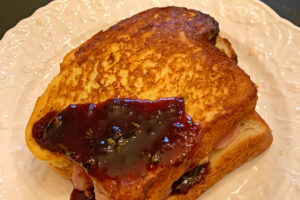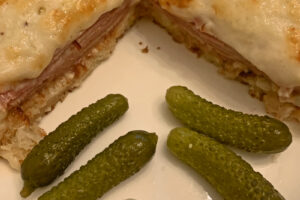For some time, I’ve been experimenting with various kinds of panini (hot pressed sandwich) in a quest to find one with a truly tantalizing taste and texture—the Panini Nord e Sud is the result. Panini became trendy in the bars of Milano in the 1970s and 1980s. Hundreds of varieties using various fillings and different breads now exist, some quite wonderful, others abominable. I assembled my panini with ingredients common to both the North and South of Italy, thus the name Panini Nord e Sud.
I begin with hot sopressata, a dry, spicy pork salami that originated in the South in Puglia, Calabria, and Basilicata. The use of generous portions of peperoncino (hot chili-pepper flakes) gives the sopressata its assertive picante quality.
For contrast, I use the far more subtle Prosciutto di Parma. Known for its sweet and delicate textured hams since the Roman Empire, true Prosciutto di Parma can be made only from the hind legs of specially selected heritage breed pigs raised in 11 regions of Italy, The claim is that the only ingredients used in manufacture are sea salt, air, and time. The hams go through a rigorous process of curing and air drying under temperature and humidity-controlled conditions for a minimum of 400 days to as long as 3 years.
Next I chose as my cheese Fontina Val d’Aosta from the northern Piedmont region bordering on France and Switzerland. This semi-soft (that is, when not fully aged) is made only from the Valdaostan Red-Spotted cows. I remove the rind, and cut one-eight-inch-thick slices from the large end of the wedge.
Two vegetables round out the filling, slices of roasted red bell peppers and sautéed broccoli rave. I prefer the Italian name rave (pronounced rah-vay) to the Americanized broccoli rabe.
The ideal bread for panini is the Ciabatta (named for its slipper shape), which was first produced by a baker in Verona in 1982.
Click here to download or print recipe



